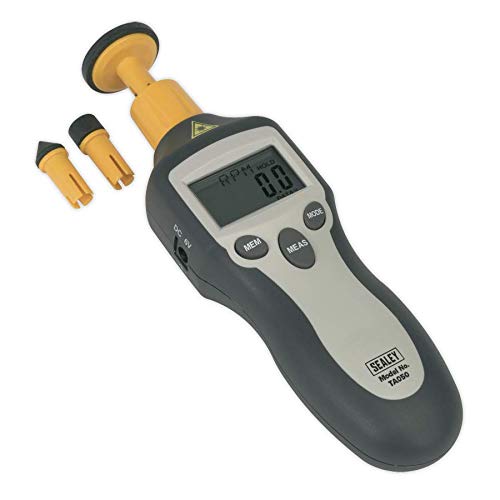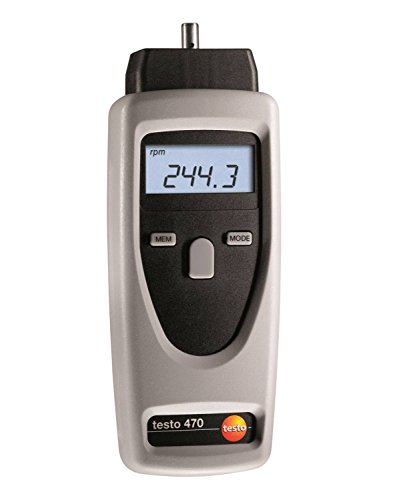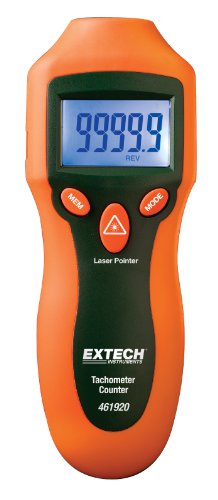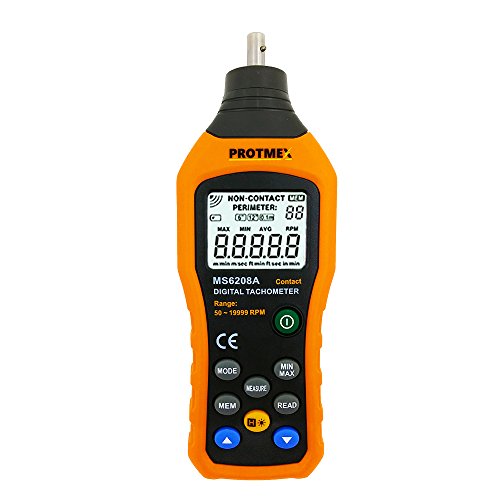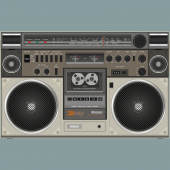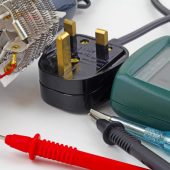A tachometer measures the rotational speed of an object such as an engine shaft or motor. It’s also called a revolution-counter.
The most common use of a tachometer is in vehicles. The gauge that indicates RPMs is a tachometer.
A tachometer is also used in many other areas and machines including engineering, airplanes, trains and tape recorders.
A digital tachometer ensures that a part or machine is running within the required parameters (e.g. the right RPMs for the selected gear). It’s also used for troubleshooting, calibration and quality assurance.
Traditional tachometers are analog in nature. They have a gauge with a scale and a needle to indicate rotational speed.
Most industries today use digital tachometers. Instead of a needle and dial, digital tachometers provide the speed readout on a display screen.
The biggest advantage of digital tachometers is the ability to store data for further analysis or transfer to a computer. Digital tachometers are also more precise, easier to use and provide advanced statistical functions.
In this buying guide, we review five highly-rated digital tachometers for use in different applications. But first, some tips on how to choose the right digital tachometer for your needs.
- Read also: Best digital oscilloscope
What To Look For When Buying A Digital Tachometer
1) Type of digital tachometer
The first thing to decide is what kind of digital tachometer you want. There are two primary types.
- Contact tachometers: These are the cheapest types of digital tachometers. They have to be in contact with whatever is being measured to take readings. They work using a freely rotating wheel.
- Non-contact/photo tachometers: These don’t need to be in contact with the target to take speed measurements. They work by aiming a laser towards the target, which has a reflective piece of tape affixed. The tachometer measures the reflected pulses to calculate rotational speed.
Most professionals prefer a non-contact tachometer as it’s more accurate and versatile.
But you don’t have to make a choice between the two. Many digital tachometers provide both contact and non-contact measuring.
Beyond these two types, there are several less common variations.
Time measurement digital tachometers measure the time between pulses to calculate speed. They are ideal for measuring low speeds.
Frequency measurement digital tachometers measure the frequency of pulses to calculate speed. They are ideal for measuring high speeds.
2) Max readings
Check the max RPMs the tachometer can measure. This is usually very high so it’s not very important for most applications.
Also check if it has minimum measurements below which it will not display readings.
3) Data storage and transfer
Almost all digital tachometers offer the ability to store readings. At the press of a button, you can recall previous readings including average, min, max and last reading.
If you need to analyse the data further on a computer, look for a tachometer that offers USB output or a removable SD card. But expect to pay more for the extra functionality.
4) Other measurements (linear speed & length)
Many digital tachometers can measure more than just RPMs. Some can also measure length and linear speed.
This provides added versatility.
5) Power supply
Digital tachometers are designed for maximum portability. So most get their power from replaceable batteries rather than being plugged in.
Check what kind of batteries the tachometer uses and make sure you can easily get them. Some use 2-4 AA batteries while others use a single 9V battery.
If you plan to use the tachometer for prolonged periods, look for one that offers a continuous power supply option, typically through a 6V DC supply.
6) Bright backlit display
Definitely get a digital tachometer with a backlit display. It allows you to take measurements in a wide range of environments and situations since you can easily see the readings.
The display should be bright enough for easy viewing in sunlight.
Some digital tachometers offer the option to adjust display brightness to make it easier on your eyes and conserve power.
- Read also: How To Choose The Best SWR Meter?
7) Accessories
Finally, check what kind of accessories the manufacturer provides along with the tachometer. Common accessories include:
- Reflective tape – for non-contact tachometers.
- Adapter heads – for contact tachometers.
- A carry/storage bag.
The Best Digital Tachometer Reviews
1. Sealey TA050 Digital Tachometer, Contact/Non-Contact
This is a dual contact and non-contact tachometer.
For non-contact measurements, it uses laser to provide quick and accurate measurements. Reflective tape is provided.
For contact measurement, it comes with three adapter heads.
In addition to rotational speed, the Sealey TA050 digital tachometer can also measure the total number of revolutions, distance and linear/surface speed.
Measurements are easy to read on the display. It’s backlit so you can use it in dark environments as well as outside.
Readings are stored in ten data sets that you can easily call up on the screen using the memory button. You can check the max, min, average or single value reading of each set.
However, there’s no option to transfer the data to a computer or some other device.
The Sealey TA050 runs on a single 9V battery that is included along with the tachometer. For continuous power supply, the tachometer has a jack socket that accepts 6V DC power supply.
The tachometer weighs just 222g, so you should have no difficulty carrying it around. It comes with a pouch for easy portability.
2. Testo 470 Tachometer, Contact/Non-Contact
The Testo 470 tachometer is another good choice if you are looking for a dual digital tachometer with contact and non-contact measurements.
The tachometer uses laser for non-contact measurements. It comes with reflective stickers that you attach to whatever you want to measure.
If you are measuring a shaft with a reflective surface, the non-contact method won’t work. The readings won’t be accurate since the tachometer is getting multiple reflections.
In that case, you can use the contact measurement probe. The Testo 470 comes with adapter that attaches to the probe tip.
The tachometer stores the mean, maximum, minimum and last reading values that you can call up on the backlit screen using the memory button.
Like the Sealey tachometer above, this one can also measure linear speed and length in addition to rotational speed. This is handy if you want to measure the length or speed of something like a conveyor belt.
Accessories provided along with the digital tachometer include batteries, probe tip, adapter, reflective markers, a surface speed measuring disk, a soft storage case and a robust transport case.
3. Extech RPM33 Contact/Laser Photo Tachometer
This is also a combination tachometer, with both contact and non-contact measuring options.
It has a contoured design that makes it easy and comfortable to hold in one hand. It’s also very light, weighing just 150g.
So you should have no trouble focusing the laser on the reflective market when using the non-contact measuring mode.
You can hold the tachometer up to 1.6 feet away from what you are measuring. This ensures safety when you are measuring a potentially hazardous machine or component that you don’t want to get too close to.
You can also measure RPMs using the contact wheel. This requires holding the wheel against the target.
The tachometer uses a quartz crystal oscillator and a microprocessor to ensure accurate measurements every time.
In addition to RPMs, you can also measure surface speed and length using the contact wheel.
Here are the min and max readings for each type of measurement.
Contact rotational speed: 2-19,999 RPM
Non-contact rotational speed: 2-99,999 RPM
Contact linear surface speed: 0.2-6560 feet/min (0-1999.9 metres/min)
Readings are shown on the brightly backlit LCD display.
You can store and recall up to 10 data sets from the tachometer’s internal memory. Each set has min, max, average and single value reading.
The tachometer runs off a 9V battery. There’s no option to use a 6V DC cord.
Accessories provided along with the tachometer include a 9V battery, carrying case and reflective tape.
4. Extech Instruments 461920 Mini Laser Photo Tachometer
This is a laser-only digital tachometer. It does not provide non-contact measurements. The upside is that it’s cheaper than dual contact/non-contact tachometers.
The downside is that it’s less versatile since you can’t measure linear speed and length, measurements that are typically taken with a contact wheel.
Like the Extech RPM33, the 461920 laser tachometer allows you to stand much further back from the target compared to other photo tachometers – up to 1.6 feet.
This is helpful when you are measuring things like spinning blades and other potentially dangerous parts and machines.
All you need to do is attach the reflective tape then stand back and direct the red light on the tape. The measurement range is between 2 and 99,999 RPMs.
The tachometer displays readings on a large backlit display. Use the memory button to recall the last, max and min readings.
The Extech 461920’s double moulded design makes it easy and comfortable to grip in your hand. The ultra-lightweight design (just 18g) also makes it easy to take accurate measurements.
The Extech 461920 comes with a 9V battery. There’s no option to connect a 6V DC power supply.
5. Protmex Digital Tachometer
This is a contact digital tachometer. It’s a great choice if you are looking for a simple and cheap digital tachometer.
It measures RPMs, like any other tachometer. It also measures rotary velocity and surface speed.
The RPM measurement range is 50-19,999 RPMs. Readings are displayed on a large backlit display that is easy to see in different light conditions.
Note: If rotational speed is lower than 50 RPMs, the screen will show zero.
The tachometer stores up to 100 data groups, much higher than the 10 you get with most digital tachometers. You can recall the max, min and average of each group.
Rotational speed readings are displayed in RPM. Surface speed readings are displayed in metres/min, feet/min or inches/min.
It uses 4 AAA batteries. A low battery indicator will come on when the batteries are almost depleted.

